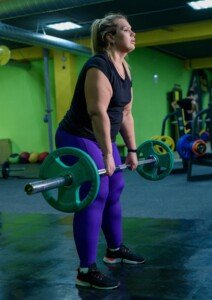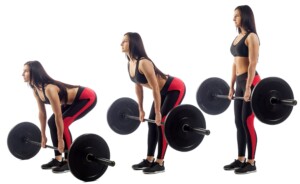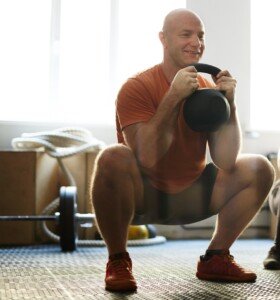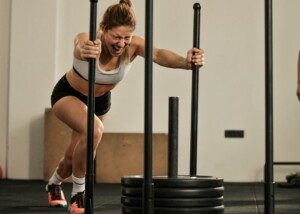Do these exercises that mimic caregiving tasks so that you can be the strongest caregiver possible with the lowest injury risk.
The following tasks come with the highest degree of difficulty to carry out:
• Transferring
• Toileting
• Bathing
• Staircase navigation
• Helping the patient up from a fall.
The best way to prevent injuries from caregiving tasks is to become proficient and strong at exercises that mimic these movements.
I’ve had plenty of experience caregiving.
This includes helping my 185-pound father out of a chair (he has had three total knee replacements, three back surgeries, a hip replacement and has peripheral neuropathy) and carefully lowering my 135-pound mother to the floor whenever she began passing out during a mysterious medical condition that caused blackouts.
But I’m also a fitness expert, having worked as a personal trainer at a health club.
Caregiving Tasks and Their Exercise Counterparts

Pushing a wheelchair = the sled push. Pushing a wheelchair may not seem like a strenuous activity, but what if you have to push it up an inclined floor for several minutes? Airports have these between automatic walkways. A path outdoors might also be inclined, such as the one adjoining two hotels in Las Vegas where I effortlessly pushed my father’s rudimentary hotel wheelchair.

Lowering a fainting person to the ground = lowering in a deadlift. Shutterstock/Reshetnikov_art

Hoisting a person up off the ground = a hybrid deadlift/squat rising upward. Shutterstock/Everyonephoto Studio

Helping a person walk while standing behind them, arms under their armpits = walking while supporting weight plates on the underside of bent forearms (as you would carry a sack).

Picking a heavy non-human object off the floor = deep squat, especially while holding something in arms. Shutterstock/Pressmaster

Placing upon and retrieving from a high shelf, heavy items = standing overhead press. Mopping, shoveling, and other floor tasks = the kettlebell swing. Shutterstock/ gpointstudio
In addition, for any kind of heavy lifting, hoisting, pushing and pulling (non-overhead) = the tire flip, sled pull, sled push, deadlift and bench press.

Tire flip. Shutterstock/MilanMarkovic78
A strong, durable core (low back and abdominal region) is essential for efficient caregiving operations and minimizing injury.
The following exercises will create a strong core: deadlift, squat, kettlebell swing, standing overhead press, to name a few.

Standing overhead press. Shutterstock/Comeback Images
Though beginners or “weak” people cannot perform a pushup, chin-up or pull-up, they sure as heck CAN perform all the other exercises listed here.
No matter how “out of shape” you think you are, you can flip a tire. It just has to be light enough.
This means a small tire. These are sold online, though some gyms have tires light enough for novices.
Whether you’ve never exercised before, are overweight or over age 50, you can learn to deadlift and squat properly.
Anyone can bench press, leg press and overhead press. Anyone can swing a kettlebell and push or pull a sled.
The weight load is highly variable. Just select the load that challenges you and patiently build up your strength.
Wheelchairs that are designed for temporary transport (such as ones provided at airports and hotels) aren’t nearly as caregiver-friendly as “permanent” wheelchairs.
If you don’t have access to a tire or sled equipment, you can still work on the other exercises. All gyms have barbells and many gyms have kettlebells.
Requirements for Making the Exercises that Mimic Caregiving Tasks Reduce Injury
#1. Start out light so that you can master form. Form must be perfect. This mastery of form will carry over to actual caregiving tasks, thereby reducing injury.
#2. Once you have form down, focus on increasing the weight over time (progressive resistance) to build a strong core and strong connective tissue; this will reduce injury.
#3. Each workout session should not exceed one hour; never work the same muscle group two days in a row.
#4. Once you have form down and base conditioning, set the resistance so that five repetitions with good form are possible, but more than 10 are impossible.
This is a general rule. But some exercises are safer than others to do up to 20-rep maximums, such as the leg press and kettlebell swing.
I can write a book on all of this, but this article is to serve as a general primer.
When you do caregiving tasks, your whole body gets involved.
This is why the exercises listed here are the ones you should get strong at.
They truly mimic the caregiver’s duties, and becoming proficient at them will reduce injury risk.










































